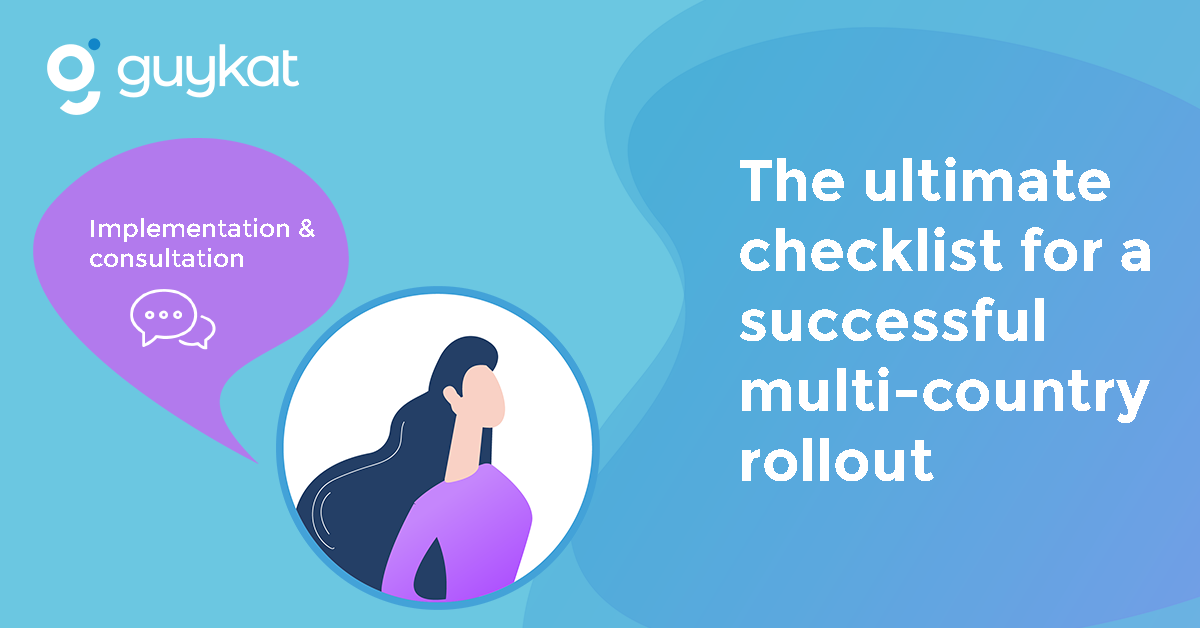At GuyKat our team have been involved with and led many multi-language, international rollouts of software solutions. We’ve developed strategies to help clients manage and ensure successful onboarding of countries and amassed some tips along the way! Our LMS Consultant Joanne Payne is sharing key takeaways of the successful multi-country rollout:
1. Establish your roll-out strategy before you begin implementation where possible.
Is there a pressing need for a ‘big bang’ launch with your software solution being rolled out to several countries in parallel? Or are you intending to pilot in one country initially, gather feedback and fine-tune your set-up before sequentially rolling out to other countries?
That is a question of horses for courses. The key is to document requirements that are core to your business regardless of location (e.g an integration with SalesForce) versus at the country level (e.g ability to integrate/support WeChat in China) to establish complexity and help with your project planning.
By taking the time upfront to consider these questions, you’ll have a clearer strategy for your vendor (or at GuyKat we much prefer being a Partner) to help you with.
2. Be careful when configuring the core components of your platform that will affect any subsequent countries.
We’ve had clients that have made configuration choices when launching in one country that is difficult to reverse or unpick later on down the line to allow other countries to easily join the platform. Certain areas of your system are inevitably going to have a site-wide impact – ensure that you have someone in your team to understand what these are and make an eyes-wide-open choice about how to configure them!
GuyKat tip: Keep an offline document of the configuration and decisions made during the original implementation for easy reference.
3. Be consistent throughout configuration with your naming and code conventions.
If we take Docebo as an example we recommend our clients implement a clear code/naming convention for certain details.
It may seem a minor step, however having this in place encourages data integrity and cleanliness across your platform, allows for clearer identification of which items belong to which country and cleaner reporting.
4. Establish what elements of your platform will be core to all countries joining vs where local flexibility is permitted.
Some of the most successful country rollout strategies we’ve been involved in are borne out of investing time and effort to get the first version/implementation right from the very start, with only minimal tweaks required later on down the line.
A great example of this is a client we worked with to implement their LMS firstly in the US. We developed a strong first version with a beautiful landing page experience and established a bespoke strategy to be used during a country onboarding.
With this understanding in place, our team developed a tailored onboarding process for this client so we could clearly speak to what items need to be fixed as they are core to brand identity (e.g the structure of their landing page is the same across all countries, they have the same brand video) along with areas that could be locally updated (one country could have an area for “Meet the Team”, another might use it for a “Social” page).
GuyKat tip: If possible, we recommend doing a pilot project. That is when a selected country goes live first. A pilot project tests all the assumptions about the use of the system in ‘the real world’ and allows configuration to be tweaked if any issues arise. With a strong proven ‘template’ you can then establish a clear onboarding process for other countries, including what elements are fixed at a global level versus what can be tailored locally.
5. Establish governance and an escalation process.
When there are multiple countries on a single platform it can present concern around how many Superadmins (with full visibility across all countries) you should have versus what responsibilities are left with the local country lead.
As a general rule, you should only have a handful of Superadmins on your platform who can make core changes for all or specific countries. Ensure there is a clear understanding of what can be done by the country administrator vs what actions require Super Admin approval or involvement. This will help eliminate confusion and frustration across your team regarding accountability.
6. Ensure there is regular communication and opportunity for local country admins to provide feedback.
It’s easy to fall into business as usual post-implementation. This results in not checking in with your local country administrators or roll-out more of the “nice-to-have” features that you may have not incorporated into the initial launch.
Your platform should evolve over time based on new features that have been released and your organisation (or customer) feedback.
GuyKat tip: You could set-up a monthly or quarterly forum to gather feedback from your countries and identify if there are patterns in requests e.g perhaps there’s a desire to expand the social area of your platform, or rollout Gamification.


